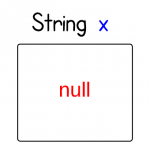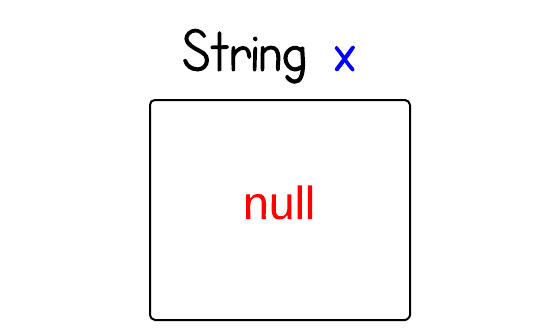Let’s start from the following statement:
String x = null; |
1. What exactly does this statement do?
Recall what is a variable and what is a value. A common metaphor is that a variable is similar to a box. Just as you can use a box to store something, you can use a variable to store a value. When declaring a variable, we need to set its type.
There are two major categories of types in Java: primitive and reference. Variables declared of a primitive type store values; variables declared of a reference type store references. In this case, the initialization statement declares a variables “xâ€. “x†stores String reference. It is null here.
The following visualization gives a better sense about this concept.

If x = “abc”, it looks like the following:

2. What exactly is null in memory?
What exactly is null in memory? Or What is the null value in Java?
First of all, null is not a valid object instance, so there is no memory allocated for it. It is simply a value that indicates that the object reference is not currently referring to an object.
From JVM Specifications:
The Java Virtual Machine specification does not mandate a concrete value encoding null.
I would assume it is all zeros of something similar like it is on other C like languages.
3. What exactly is x in memory?
Now we know what null is. And we know a variable is a storage location and an associated symbolic name (an identifier) which contains some value. Where exactly x is in memory?
From the diagram of JVM run-time data areas, we know that since each method has a private stack frame within the thread’s stack, the local variable are located on that frame.
References:
1. Variables, Operators, and Expressions
2. Variable
3. JVM Specifications

i think string.isblank(x) is the right approach, beacuse it checks all the three like witespace, null or empty however the x==null checks only if the x is null or not , but is will not let you know if is whitespaced or empty
How do I check whether the x is blank or has some values ?
x == “” or x == null, which is the right approach ?
Probably he was writing this post while he was waiting for a dinner, a nice steak 🙂
Very Helpful .. Thanks
In the second paragraph of the third section, “we know that since each method has a private stack frame within the thread’s steak”, it seems that the last word should be “stack” rather than “steak”